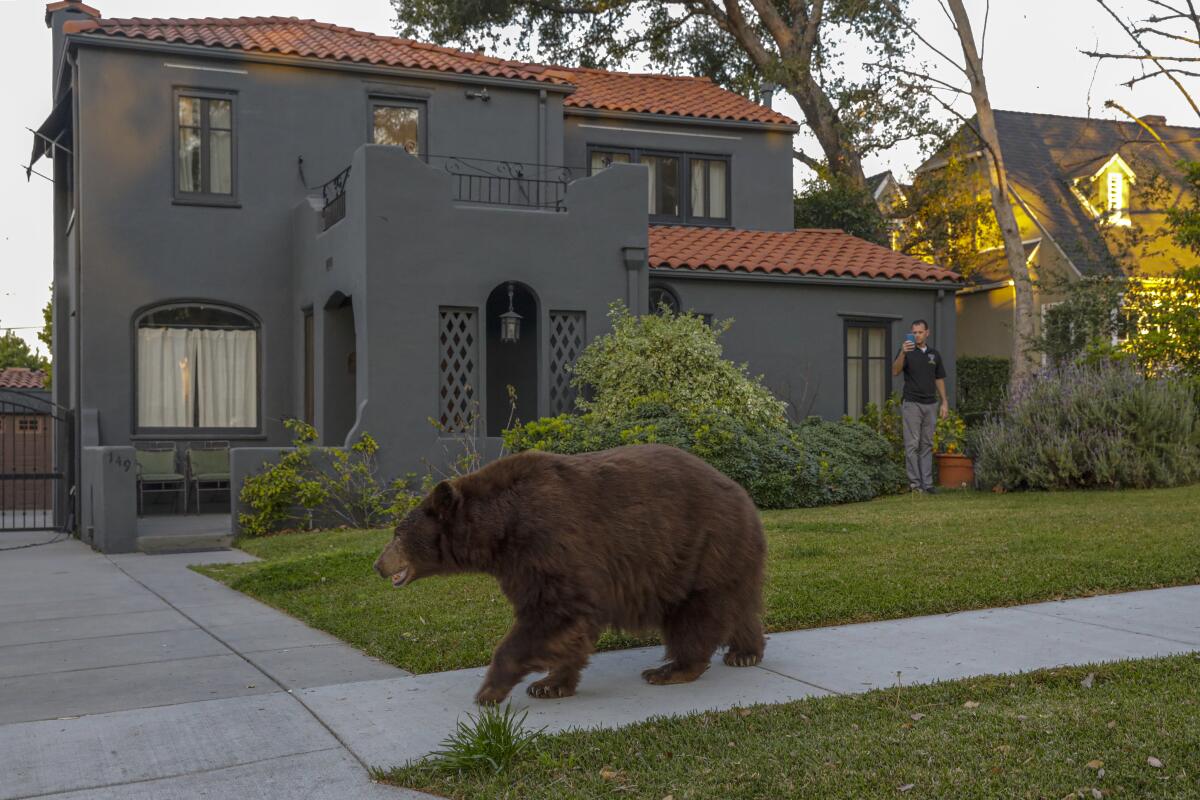Extremely hungry bears are a troubling consequence of California’s epic snowpack

- Share via
As they do every spring, the bears of the Eastern Sierra Nevada are now clawing their way out of dens after their five-month-long winter naps, tearing through layers of ice and snow with little air to breathe and no water to drink.
They can’t afford to stop because they haven’t eaten since late October, when they entered their dens for the brutal Sierra winter, usually by burrowing into north-facing slopes. Some had cubs in tow; others gave birth in the midst of hibernation.
This year, though, they emerge to face an unprecedented accumulation of snow. This has been a monstrous winter for my hometown, Mammoth Lakes. The snow-globe vistas and epic skiing have delighted many. But the historic snowfall is about to take a toll on the iconic black bears of the Eastern Sierra.
Not only did we get far more snow than usual, but the spring thaw is two months behind schedule. Three-story cabins are still buried beneath record snowdrifts. And with roads walled in, there is nowhere for animals even to walk other than the busy streets in town.
Most unsettling is the famine they face. The tender, translucent shoots of weeds and grass that are their post-winter caviar are nowhere to be found. The food lies dormant beneath layers of snow.
What’s a young mother with two cubs to do? Most parents would do anything to feed their children, and so will she.
And what about the rest of the region’s wildlife — the bobcats, the mountain lions and that lone coyote that has been sitting long days outside the local Carl’s Jr.? With no voles or mice to eat, he has resorted to begging for fries.
During my long run as Mammoth Lakes’ wildlife officer, food was at the forefront of my efforts to help the town’s humans and animals coexist. Mammoth has long prided itself on an enlightened approach to wildlife, accepting it as part of our daily lives. For three decades, it was part of my job to keep the bears out of harm’s way by keeping them out of hotel lobbies, schoolyards, cabins and cars. Mostly, we succeeded.
Over time, I became known as the town’s “Bear Whisperer.” I even crawled into their dens to study them, placing microphones and cameras within while they slept. But the town’s residents deserve as much credit as I do for the progress we made.
When I began the job, restaurants dumped leftovers in unlocked dumpsters each night, and bears and other animals fed freely, leading to overpopulation and uncomfortable encounters with humans. Over time, we were able to lock down the dumpsters and force the animals to feed on seeds, bugs, grubs, grasses and all the other natural foods that keep them healthy and fit.
Our mantra, which can still be seen on bumper stickers around the state, became: “Don’t Feed Our Bears.”
But now, with no natural food available, what should the bears and other animals eat? Should the state step in and provide food? Should homeowners?
I confronted that question the other day at my own doorstep, where a hungry raccoon showed up. The masked-bandit bottom feeders of the forest are notoriously adept at finding everything from grubs under your sod to chicken in your tent. But this one had been reduced to an example of the plight of our starving wildlife, going door to door for a can of cat food or other handout.
While it would feel humane to oblige, I would strongly discourage such a gift even now, and state officials also eschew such interventions as a matter of policy. Feeding wildlife can only encourage animals to return to human sources again and again over the long term, even after natural foods become available. (It’s also illegal.)
Not that I welcome what we’re about to witness. The coming compressed summer will be really hard on the animals, and the next five weeks will be critical.
An influx of bears is inevitable in towns and exurbs on the edge of the wilderness, which they will see as their honeypots, increasing the sort of run-ins with humans that don’t usually benefit either species. More peril awaits wildlife munching on the first shoots of spring in one of the few places they can find them — along roadsides next to speeding cars.
Can the bears fatten up enough by October to survive next winter? This may be a moment when only the savviest bears survive, and in the long run the species may get stronger as a result. The bears have to adapt. Will we?
It’s been a great year for us in crucial respects. All this water is a blessing. But for the bears, it comes with a heavy price.
Steve Searles served as Mammoth Lakes’ wildlife officer from 1996 to 2020. A book on his life with nature, “What the Bears Know,” is expected to be published in October.
More to Read
A cure for the common opinion
Get thought-provoking perspectives with our weekly newsletter.
You may occasionally receive promotional content from the Los Angeles Times.









